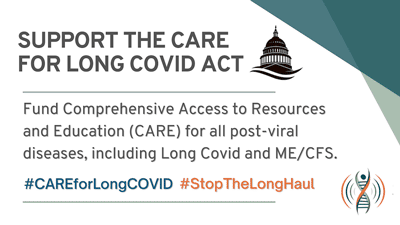Advocacy Month Details Waiting on Broken Budget
Our advocacy is expanding. We have more advocates every year. We’re reaching more people, recruiting more allies to our side every year – so it makes sense that Advocacy Week is no longer Advocacy Week but that the entire month of May is now Advocacy Month. That means our advocacy days are going to be more spread out – giving our precious ME/CFS advocates more time to rest and recover between sessions. It’s a win for everyone.

A broken budget process in Congress is preventing Solve M.E. from solidifying what we’ll be doing during May in Advocacy Month.
So, what is surely going to be in the biggest Advocacy Month to date? We don’t know yet. Emily Taylor – the leader of Solve M.E.’s legislative advocacy effort – explained that the budget process is extraordinarily confused right now. (She called it a “hot mess”.) We’re not going to be able to decide on our ask until the Biden administration provides its 2023 budget, which has been delayed while it’s been waiting for Congress to meet its obligations for the 2022 budget (yes, that’s the 2022 budget) – probably in March 2023.
To me – that’s the bad and good news. The bad – that Congress continues to redefine what the term “broken” means. The good news, though, is that we have a professional advocate with her ear to the ground who’s taking a strategic approach to advocacy. Solve M.E. is not going to simply ask that ME/CFS gets “x” dollars – it’s going to see what opportunities the President’s budget request provides and then determine the best targets in them. That’s smart advocacy.
Sign Up Here to Participate in Advocacy Month
The budget isn’t the only thing in play, though. In fact, there’s some really good news. The abandonment of the Build Back Better legislation has left a lot of legislative balls in the air, several of which could benefit us enormously.
Opportunity Knocks in Major Bills

Opportunity is knocking for ME/CFS, fibromyalgia and long COVID right now.
It’s been said many times: if you want to make really major change in these diseases, Congress is the place to do it. We saw what a dramatic difference Congressional advocacy can make when Congress gave the NIH over a billion dollars to study long COVID.
Emily estimates we have about 6-8 months while the COVID-19/long-COVID iron, so to speak, is hot, to create seminal and long-lasting changes in how ME/CFS and long COVID are treated.
This year there are plenty of opportunities to do that.
21st Century Cures for Long COVID and ME/CFS
21st Century Cures 2.0 – The original 21st Century Cures bill passed in 2016 focused on, among other things, finding ways to speed treatments through the onerous FDA approval process. We tried but failed to get support for ME/CFS included in that bill.
Now the bill’s original authors are back with 21st Century Cures 2.0, and we’re back as well, but five years of working at the federal level have put us in much better shape. The bill prominently includes support for long COVID – in fact, it’s the first topic mentioned.
Emily reported that Solve M.E. and Congressmen Jack Bergman and Don Beyer have successfully gotten provisions from H.R. 2754, a 2021 bill that explicitly supported both long COVID and crucially, post-viral illnesses (i.e. ME/CFS) folded into the bill. Plus, Representatives DeGette and Upton supported our efforts to get key provisions about medical and public education folded into the Cures 2.0 bill as well.
New Agency – New Mandate – New Opportunity for ME/CFS
Another scintillating opportunity comes from Congresswoman Anna Eschoo – one of our strongest ME/CFS and long-COVID supporters. Rep. Eschoo has gotten the ARPA-H bill (see Solve M.E. action item) absorbed into the Cures 2.0 bill.

ARPA-H is designed to support innovation and high-risk, high-reward projects.
ARPA-H (Advanced Research Projects Agency for Health) creates a medical research institution that may, depending on which model is embraced, sit outside the NIH. APRA-H is designed to “promote high-risk, high-reward innovation to develop high-need cures”.
In “A new agency to accelerate biomedical science can succeed, under the right conditions”, two commentators asserted that for ARPA-H to succeed it’s essential that it be housed outside the NIH, and Eschoo’s version does that.
When the NIH will not fund clinical trials for ME/CFS because it doesn’t know enough about the disease (but won’t provide the funding opportunities needed to learn about it), you can see how desperately something like ARPA-H is needed. Ditto with low dose naltrexone and dextro-naltrexone – two potentially cheap and effective pain relievers – which, in the midst of an opioid crisis that the NIH has been tasked to fix – the NIH refuses to fund.
As Ron Davis has pointed out many times, the NIH is reluctant to fund explorations into new technologies, yet new technologies are exactly what ARPA-H is intended to accelerate.
Finally – A Disease Burden Institute?

Bullseye – language in Anna Eschoo’s ARPA-H bill couldn’t be better aimed at ME/CFS.
Developing new technologies is all for the good, but there’s one provision of the bill that should get everyone out of their chair. Along with other factors, the bill states ARPA-H will take into account “the effect on disease burden, including unmet patient needs” and “health equity” in its funding decisions.
That’s worth repeating. Embedded in the language creating ARPA-H is a provision that requires the new agency to take into account “disease burden”, “unmet patient needs” and “potential opportunities to advance health equity.” You couldn’t have written a sentence that more targets ME/CFS than that. ME/CFS is the poster child for unmet patient needs, for unacknowledged disease burden, and for a lack of health equity.
It’s the NIH’s inability, or unwillingness, to bring disease burden or unmet needs into its funding equations that has kept large, common, but poorly funded, diseases like ME/CFS and fibromyalgia from getting the support they deserve. Without those factors figured in, it’s been impossible to get past the anti-ME/CFS bias, and the chokehold the big diseases have on funding.
That was demonstrated in spades when we actually lost support at the NIH during a pandemic that created millions of ME/CFS-like cases in the U.S. That bears repeating as well. Even in the midst of a tsunami of long-COVID (er, ME/CFS) cases hitting our medical system, the number of Institutes that were willing to provide even a small amount of money for the ME/CFS research dropped dramatically. Somehow, we lost ground.
In the ARPA-H bill, we have a potential antidote for that and the possibility for recognition and funding.
The Care for Long COVID Act
“I tell people it feels like all my nerves have had like five cups of coffee,” Senator Tim Kaine on having long COVID
The title is a bit misleading. S.3726, the Comprehensive Access to Resources and Education (CARE) for Long COVID Act, doesn’t just cover long COVID, it also covers post-infectious illnesses. Senator Tim Kaine (D-VA) – who still has long COVID; longtime ME/CFS champion, Senator Ed Markey (D-MA); and Senator Tammy Duckworth (D-IL) unveiled the act about ten days ago.

- Accelerate research by centralizing data regarding Long Covid and related post-viral illness patient experiences;
- Increase understanding of treatment efficacy and disparities by expanding research to provide recommendations to improve the health care system’s responses to Long Covid and related post-viral illnesses;
- Educate the public and medical providers by working with the CDC to develop and provide the public with information on common symptoms, treatment, and other related illnesses, specifically ME/CFS.
You can support this bill, which Solve M.E., long-Covid families, and other advocates were involved in from the beginning, right now.
Take Action Now
Pandemic Preparedness Package Potentially Provides Centers of Excellence for ME/CFS and Long COVID
Recently named the PREVENT Act, Emily reported that the package creates Centers of Excellence that support both long COVID and potentially other post-infection research and treatment, which would be a huge win for our communities that desperately need access to good doctors. Legislation supporting COEs didn’t make it through last year but has been absorbed into a “Pandemic Preparedness Package.”
The Long-COVID / ME/CFS Gap

A few long-COVID advocates are trying to stop ME/CFS from benefitting from the NIH’s long-COVID funding.
Money has been falling from the sky for long-COVID researchers, but ME/CFS is still being funded at the same old petty pace. There’s simply no way at its current level of funding that the ME/CFS field can, within a reasonable amount of time, apply the breakthroughs that are sure to come in long COVID.
The NIH’s decision not to allow even 500 ME/CFS patients into its 17,000 person long-COVID cohorts, its decision not to increase funding for three small research centers, and the 7-month gap in funding for the research centers means that the ME/CFS field continues to starve in the midst of plenty. I asked Emily, what, if anything, can be done about this situation?
Her answers were illuminating. For one, a few vocal and apparently influential long-COVID leaders have been working to block the NIH combining its long-COVID work with work on any other post-infectious illnesses. Of course, it’s entirely predictable that when faced with a threat, some people will become self-centered, rigid, and uncaring. It’s particularly jarring to hear, though, when a disease like long COVID has been given such enormous funding.
From Emily:
“a few vocal minority voices (from the long COVID community) have put the NIH in a difficult position”
“Both Congress and the Executive branch could take simple and immediate action to prioritize and distribute funding differently, and provide policy guidance to key leaders to include other post-infection diseases like ME/CFS in long-COVID programs. However, there are two big barriers to that happening.”
“The first: there is pressure from the long-COVID community against being associated with or studied with other post-infectious existing illnesses. This position does not represent the majority of long-COVID community leaders, but a few vocal minority voices have put the NIH in a difficult position regarding merging existing programs and the new RECOVER Initiative. There are some in the long-COVID community who oppose such collaboration and cross-pollination with ME/CFS experts. The NIH is working with these community members also.”
Emily added this to clarify:
“Some Long COVID patients are wary of existing illnesses and voice their opinions against comparing Long COVID to other post-viral conditions like ME/CFS, or POTS. I feel that these folks have not taken advantage of the robust resources available from these communities or lack the potential educators around them to explain the overlaps and the clear scientific connection to Long COVID. But, we are fortunate because the vast majority of the patient-led organizations in the Long COVID community understand these connections and that we are stronger when we work we together. You can see evidence of that success through our collaborative efforts in Congress.
However, the RECOVER Initiative and other research advisory councils include varied participation and not all of these representatives recognize the link between Long COVID and existing post-viral illnesses. That is why Solve M.E. and our Long COVID partners are currently working on launching a new training program to educate, empower and elevate patient leaders in key roles on research advisory committees.”
Many thanks!
The Budget Issue
The Gist
- A budget impasse dating back to last year is preventing Solve M.E. from finalizing its plans for Advocacy Month in May, and is inhibiting the NIH from providing more resources for anyone for the coming year. Sign up for Advocacy Month here.
- A few long-COVID advocates have been dedicated to ensuring that ME/CFS and other post-viral diseases do not directly benefit from the NIH’s RECOVER long-COVID research initiative.
- Big opportunities loom on the Congressional front, though. Emily Taylor of Solve M.E. believes we have 6-8 months to strike while the long-COVID iron is hot.
- Advocates have enfolded language that includes support for both post-viral illnesses and long COVID in the big 21st Century Cures 2.0 bill.
- The creation of ARPA-H – an organization dedicated to supporting innovative high-reward, high-risk efforts – is slated to take into account three magic factors for ME/CFS and allied disorders: disease burden, patients’ unmet needs, and health inequities.
- The Care for Long COVID Act would centralize data for long COVID and post-infectious illness, provide funding to assess treatments, and educate doctors. Support that effort here.
- The Pandemic Preparedness or PREVENT package could potentially create Centers of Excellence that would research and treat long COVID and people with post-viral illnesses (such as ME/CFS).
From Emily:
“I completely understand why NIH is unable to offer additional resources currently.”
“Second, I cannot emphasize enough what a powerful factor budget uncertainty is. I completely understand why NIH is unable to offer additional resources currently. Simply put: Congress prevented any funding increases at this time. This is happening because the NIH does not have a budget. Without a budget, it cannot promise money it doesn’t have. The only budget the NIH has at their disposal right now is identical to last year. Therefore, the only money the NIH can commit is the exact same funding as last year. Any hope for a funding increase this year was dashed by Congress’s inability to pass a budget on time.”
“The good news is this is an area where we can make an impact. Solve M.E. recently drafted a letter to Congress calling attention to these funding gaps and impacts because of the federal budget situation. By calling attention to these needs, we establish a history regarding the damage caused by the budget delay, and urge them to prioritize funding for programs harmed by the budget delays (like the ME/CFS centers).”
Conclusion
A broken budget process dating back to last year is holding things up at the NIH, and a few long-COVID advocates are trying to exclude ME/CFS and other post-infectious diseases from directly benefitting from the Congressionally funded long-COVID research at the NIH.
Three big bills already underway demonstrate, once again, how incredibly effective advocacy at the Congressional level can be.
Advocates on the Hill have allied with Congressmen and women to insert key provisions which include post-viral illnesses in the 21st Century Cures 2.0 bill. Among the most exciting of those are the creation of a new organization, ARPA-H, (hopefully outside of the NIH), that is dedicated to accelerating innovation, and which includes taking into account disease burden, patients’ unmet needs, and health inequities in its funding decisions.

Bills moving through the legislature appear to provide the opportunity to break some of the chains that have thwarted ME/CFS for so long.
The Pandemic Preparedness or PREVENT package also includes language that creates Centers of Excellence for long COVID and post-viral illnesses.
Plus, the recently introduced “Care for Long COVID Act” also contains language explicitly including ME/CFS, fibromyalgia, and POTS, in its plans to create a centralized database, expand research into treatments, get doctors better informed about these diseases and others. You can support this bill now.
We’ll be tracking these bills as they move through Congress.






Thank you so much for this information. It is heartening to know that there is some good movement at the Legislative level. However, it is worrisome that the Long Covid group does not want to include other post-infectious illnesses in their endeavors … If their research is fruitful, will the original long haulers have access to those treatments? Lots of uncertainties at this point ….
I want to emphasize that Emily said that most long COVID advocates are behind us and that it’s just a few. They are, however, apparently having an effect.
The best news was that whatever effect they’re having on the NIH and its long COVID funding, advocates have apparently inserted language into various bills which do include ME/CFS within long COVID funding.
I don’t think it can be overemphasized how potentially effective Congressional advocacy can be. It’s the hardest kind of advocacy, it can take years of work for it to pan out, and it can be thwarted by political currents shifting this way and that, but it has the potential, like nothing else does, to dramatically shift ME/CFS and fibromyalgia and long COVID research and treatment funding.
I don’t believe that the force working against funding for ME/CFS research is a lack of understanding. I used to believe that, but after following the history of the disease it goes against logic. I think the force is greed – and I think it’s clever. So I wonder if there are avenues apart from the NIH and CDC. I realize that NIH funding would allow for large scale studies. However, I wonder about directing resources toward avenues less likely to look the other way . The CDC and NIH do not seem “motivated” to work in our favor. Perhaps I am being naive as I don’t fully understand how the funding works. I do know, however, that the truth does not seem to move people. The truth only moves people when they are ready for it. I
I don’t see any path forward for us in the NIH without Congressional action. I would love to be proved wrong but what history tells us is that any action the NIH takes will be immeasurably smaller than what we need.
That’s why ARPA-H is so potentially exciting. It includes within it language that takes into account disease burden and unmet patient needs. That’s what’s missing at the NIH – and that could prove hugely helpful.
I 100% agree!!
I’m with you poppy
I’m curious how you mean greed..in what form? Several years ago, when funds were illegally diverted from ME research, it made me think something was amiss. I felt like like they didn’t want to find out what the cause and/or treatment of ME is. Somehow I feel pharmaceutical companies are benefiting financially from the myriad of medications we have to take to manage our symptoms. I was wondering if this is what you meant?
Who are the Long Covid group trying to block the inclusion of ME/CFS? I know you may not want to say it publicly, and you may not know, but I want know to so I can fight them! How dare they.
Jennifer Mayberry, March 2020 Covid Long hauler
@Longcovid2mecfs
I actually don’t have a clue!
If Emily has specifics on this, please get her to go on the record. Her organization (Solve ME) leads the Long Covid Alliance, and in those meetings, which I attended, this issue was never raised. If there are specifics, please provide them. Just the notion that this division might exist (and I don’t believe it does) could do lasting damage, and people with these views should be called out. They should not be allowed to work in the shadows.
Emily said it was a few advocates – maybe that’s why they didn’t show up in the discussions or perhaps they’re not part of the Long COVID Alliance?
She added this to clarify her statement:
“Some Long COVID patients are wary of existing illnesses and voice their opinions against comparing Long COVID to other post-viral conditions like ME/CFS, or POTS. I feel that these folks have not taken advantage of the robust resources available from these communities or lack the potential educators around them to explain the overlaps and the clear scientific connection to Long COVID. But, we are fortunate because the vast majority of the patient-led organizations in the Long COVID community understand these connections and that we are stronger when we work we together. You can see evidence of that success through our collaborative efforts in Congress.
However, the RECOVER Initiative and other research advisory councils include varied participation and not all of these representatives recognize the link between Long COVID and existing post-viral illnesses. That is why Solve M.E. and our Long COVID partners are currently working on launching a new training program to educate, empower and elevate patient leaders in key roles on research advisory committees.”
Many thanks!
They are probably worried long covid will be associated with ME and therefore will be ignored. I have read several articles that indicate people with long covid are receiving many supports that have never been an option for me. I find it very difficult to not be resentful to have people who are sick for a year or two going to the front of the line, when many of us have suffered for decades with no help.
“ That’s worth repeating. Embedded in the language creating ARPA-H is a provision that requires the new agency to take into account “disease burden”, “unmet patient needs” and “potential opportunities to advance health equity.” You couldn’t have written a sentence that more targets ME/CFS than that. ME/CFS is the poster child for unmet patient needs, for unacknowledged disease burden, and for a lack of health equity.”
Wow! It’s hard to believe that language is actually in there. It sounds like something you’d find in a paper written by knowledgeable ME advocates, who have been pointing this out for decades. Truly incredible it made it into the language.
Yes! We have to be cautious because the bill does cite other factors to be taken into account – but it sure sounds like something an ME/CFS advocate pressed to get into the bill. I wouldn’t be surprised at all. 🙂
Good luck for developments in the US!
I’m glad that the two biggest ME/CFS and LongCovid patient organisations in Germany seem to be working together quite well. They’ve co-written a proposal for a national action plan for ME/CFS and Post-Covid-Syndrome. Things still need to speed up so much more!
Holding fast for ARPA-H success. NIH just doesn’t it. Unmet patient needs, acknowledged disease burden, and health equity? Powerful stuff!! I will hope for ARPA-H finally addressing our invisible struggles. Way to go Cort for a thoughtful account of current funding and research.
Thanks, Sylvia – I am really holding out hope for ARPA-H!